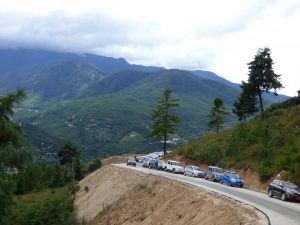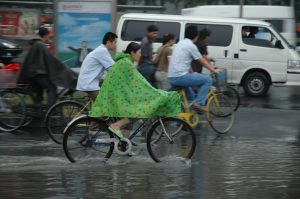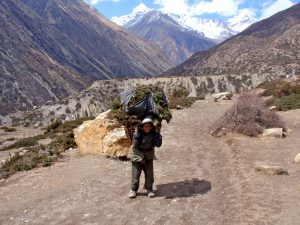In the highlands of Bhutan, livelihoods change and adapt. While highlanders once depended on rearing livestock such as yak and sheep, most now make a living by gathering cordyceps, commonly known as yartsa goenbub. But as global warming threatens the quantity of the fungus, it may be that highlanders will have to return to their former livelihoods to survive.
Cordyceps is the name of a parasitic fungus that attacks a number of insects, most notably caterpillars. The fungus germinates in the living larva, kills and mummifies it, and then a dark-brown, stalk-like fruiting body – just a few centimetres long – emerges from the corpse. Also known as caterpillar fungus, cordyceps are only present above 4,000 – 5,000 metres altitude and are found in the high Himalayan regions of Bhutan, Nepal, India and China. Once collected, cordyceps are usually auctioned off to exporters through a strict monitoring process and are sent to other countries where they are used in medicine.
Before the collection of the fungus was legalised in 2006, farmers were fully dependent on livestock, such as sheep, yak and horses, and their products to make a living. Those who had many animals were thought of as rich and powerful in the community.
In legalising the collection of cordyceps, the intention was for highlanders to gather the fungus while also rearing yaks, says Tauchu Rabgay, head of the highland development programme at the Department of Livestock. This was the wish of the king, which is why only highlanders were granted the permission. The Department of Forest and Park Services strictly monitors the situation and there are heavy fines for those collecting cordyceps illegally.
But the economic benefits of collecting and selling cordyceps have been enough for highlanders to abandon animal rearing completely. Yak herders in Sephu Gewog, Wangdue Phodrang District, say that one season of collecting cordyceps earns them the same amount of money as rearing 50 yaks once did. Although the price varies slightly from place to place, the highest price fetched by a kilo of high quality cordyceps this year was 2.71 million ngultrum (USD 42,000). On the other hand, a farmer can earn about 10,000 ngultrum (USD 155) in a year by selling cheese, butter and milk from yaks.
Highlanders also lost interest in rearing yaks due to their low return, which was sometimes not even enough to feed their own families. Two milking yaks used to produce at least five kilogrammes of butter, earning the farmer 1,000 ngultrum (USD 15) a month. But today, four or five yaks are needed to produce the same amount, and no one knows why.
Read: Consider the Yak
The decline in the number of animals began after farmers started collecting cordyceps, according to the Department of Livestock, from 39,500 yaks in 2013 to 38,200 in 2015. In Sephu Gewog, Wangdue Phodrang District, there used to be more than 100 herds – one in every family – but there are now just 42 yaks and a calf. The decline in animal rearing has also posed a threat to the loss in yak products such as meat, wool, cheese and clothes, impacting age-old traditions.
Lekey Dorji is the last herder in the seven-household village of Sertang in Sephu Gewog. He was born and brought up as a yak herder, like his parents before him, and he has been with the animals ever since. He used to have more than 100 yaks, but today he has little more than 50; some died and some he sold. His biggest challenge is the lack of pasture land for the yaks and the ever-present danger of tigers attacking his herd. Many herders say they need compensation from the government when a tiger attacks their animals.
But while yak herding has its challenges and the lucrative price of cordyceps has driven herders crazy, there are no guarantees to collecting the fungus; every year the amount of cordyceps in the mountains declines. And even though it is not yet cultivated commercially and wild cordyceps must be collected by hand, over-harvesting and overexploitation has led to the fungus being classified as an endangered species in China. And now some highlanders worry that the fungus may disappear when the region becomes warmer. Even the village headman, known as Tshogpa Phurba, said that climate change may lead to decline in the fungus, creating a disaster for the highlanders.
And so today most highlanders from Sephu village say it is high time for them to revive yak herding, and the Department for Livestock agrees.
“We are planning different activities to give highlanders the same opportunities as those farmers living in lower valleys,” says Tauchu Rabgay. “In the same way that other government departments have provided them with facilities such as schools and hospitals, the department of livestock will provide them with the veterinary hospitals for their animals. They will also be given fodder, seeds, and modern equipment for producing yak products. In the past, the return from the yaks only consisted of cheese, butter and meat, but now we are planning to improve those products and try to export them.”
“There are chances that cordyceps will disappear one day. At such a time, the highlanders might suffer and will have to depend on their livestock once again. But it will be a difficult task for everyone to revive the tradition of rearing yaks and other animals then. Before this fungus vanishes, I urge everyone to rear at least a few yaks. The government and the herders should work together to protect these animals into the future.”
![<p>Tiny, but very expensive, cordyceps can only be found in the high Himalayan terrain [image by: Yen L./Flickr]</p>](https://dialogue.earth/content/uploads/2017/09/Cordyceps-by-Yen-L.jpg)







